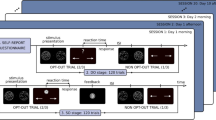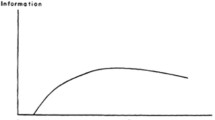Abstract
We examine whether emotion can encourage inertial decision making, which is an emergent research topic in online shopping. Based on the information processing view, inertia is conceptualized as a decision process that involves repeated usage of a similar effortless information search pattern across multiple problems, and we propose that this conceptualization can be quantified using an eye-movement index based on the string-editing algorithm. We then examine whether positive moods, which have been shown to increase impulsive shopping, may promote inertia. Subjects, who either received positive moods priming or calculation (mood-suppressing) priming, participated in an eye-tracking experiment with multi-attribute decision tasks presented in a web map format like the Google Maps. The results showed that positive moods increased process inertia. We conclude that inertia can be quantified according to the information processing view, and that happy consumers tend to repeatedly use an effortless information search pattern to evaluate multiple products.
Access this chapter
Tax calculation will be finalised at checkout
Purchases are for personal use only
Similar content being viewed by others
References
Polites, G. L., & Karahanna, E. (2012). Shackled to the status quo: The inhibiting effects of incumbent system habit, switching costs, and inertia on new system acceptance. MIS Quarterly, 36(1), 21–42.
Johnson, E. J., Schulte-Mecklenbeck, M., & Willemsen, M. C. (2008). Process models deserve process data: Comment on Brandstatter, Gigerenzer, and Hertwig (2006). Psychological Review, 115(1), 263–273.
Payne, J. W., Bettman, J. R., & Johnson, E. J. (1993). The adaptive decision maker. Cambridge, UK: Cambridge University Press.
Kiesel, A., et al. (2010). Control and interference in task switching—A review. Psychological Bulletin, 136(5), 849.
Huang, Y.-f., & Kuo, F.-y. (2012). How impulsivity affects consumer decision-making in E-commerce. Electronic Commerce Research and Applications, 11(6), 582–590.
Schulte-Mecklenbeck, M., Kühberger, A., & Johnson, J. G. (2011). A handbook of process tracing methods for decision research: A critical review and user’s guide. Psychology Press.
Riedl, R., Brandstätter, E., & Roithmayr, F. (2008). Identifying decision strategies: A process-and outcome-based classification method. Behavior Research Methods, 40(3), 795–807.
Payne, J. W. (1976). Task complexity and contingent processing in decision making: An information search and protocol analysis. Organizational Behavior and Human Performance, 16(2), 366–387.
Josephson, S., & Holmes, M. E. (2002). Attention to repeated images on the world-wide web: Another look at scanpath theory. Behavior Research Methods, Instruments, & Computers, 34(4), 539–548.
Day, R. F. (2010). Examining the validity of the Needleman-Wunsch algorithm in identifying decision strategy with eye-movement data. Decision Support Systems, 49(4), 396–403.
Fazio, R. H. (1995). Attitudes as object-evaluation associations: Determinants, consequences, and correlates of attitude accessibility. In Attitude strength: Antecedents and consequences. Mahwah, NJ: Lawrence Erlbaum.
Samuelson, W., & Zeckhauser, R. (1988). Status quo bias in decision making. Journal of Risk and Uncertainty, 1(1), 7–59.
Dubé, J. P., Hitsch, G. J., & Rossi, P. E. (2010). State dependence and alternative explanations for consumer inertia. The Rand Journal of Economics, 41(3), 417–445.
Buettner, R., et al. (2018). Real-time prediction of user performance based on pupillary assessment via eye tracking. AIS Transactions on Human-Computer Interaction, 10(1), 26–56.
Monsell, S. (2003). Task switching. Trends in Cognitive Sciences, 7(3), 134–140.
Fennema, M. G., & Kleinmuntz, D. N. (1995). Anticipations of effort and accuracy in multiattribute choice. Organizational Behavior and Human Decision Processes, 63(1), 21–32.
Sénécal, S., et al. (2015). Consumers’ cognitive lock-in on websites: Evidence from a neurophysiological study. Journal of Internet Commerce, 14(3), 277–293.
Pham, M. T. (1998). Representativeness, relevance, and the use of feelings in decision making. Journal of Consumer Research, 25(2), 144–159.
Bettman, J. R., Luce, M. F., & Payne, J. W. (1998). Constructive consumer choice processes. Journal of Consumer Research, 25(3), 187–217.
Andrade, E. B. (2005). Behavioral consequences of affect: Combining evaluative and regulatory mechanisms. Journal of Consumer Research, 32(3), 355–362.
Garbarino, E. C., & Edell, J. A. (1997). Cognitive effort, affect, and choice. Journal of Consumer Research, 24(2), 147–158.
Creyer, E. H., Bettman, J. R., & Payne, J. W. (1990). The impact of accuracy and effort feedback and goals on adaptive decision behavior. Journal of Behavioral Decision Making, 3(1), 1–16.
Hsee, C. K., & Rottenstreich, Y. (2004). Music, pandas, and muggers: On the affective psychology of value. Journal of Experimental Psychology: General, 133(1), 23–30.
Wells, J. D., Parboteeah, V., & Valacich, J. S. (2011). Online impulse buying: Understanding the interplay between consumer impulsiveness and website quality. Journal of the Association for Information Systems, 12(1), 32–56.
Day, R. F., et al. (2009). Effects of music tempo and task difficulty on multi-attribute decision-making: An eye-tracking approach. Computers in Human Behavior, 25(1), 130–143.
Author information
Authors and Affiliations
Corresponding author
Editor information
Editors and Affiliations
Rights and permissions
Copyright information
© 2020 Springer Nature Switzerland AG
About this paper
Cite this paper
Huang, Yf., Kuo, Fy. (2020). Positive Moods Can Encourage Inertial Decision Making: Evidence from Eye-Tracking Data. In: Davis, F., Riedl, R., vom Brocke, J., Léger, PM., Randolph, A., Fischer, T. (eds) Information Systems and Neuroscience. Lecture Notes in Information Systems and Organisation, vol 32. Springer, Cham. https://doi.org/10.1007/978-3-030-28144-1_25
Download citation
DOI: https://doi.org/10.1007/978-3-030-28144-1_25
Published:
Publisher Name: Springer, Cham
Print ISBN: 978-3-030-28143-4
Online ISBN: 978-3-030-28144-1
eBook Packages: Business and ManagementBusiness and Management (R0)




